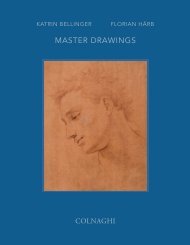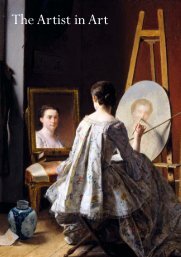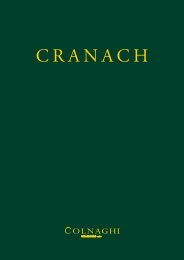2007 Catalogue - Colnaghi
2007 Catalogue - Colnaghi
2007 Catalogue - Colnaghi
Create successful ePaper yourself
Turn your PDF publications into a flip-book with our unique Google optimized e-Paper software.
22<br />
Louis-Rolland Trinquesse<br />
(Dijon 1745 – 1800 Paris)<br />
Portrait of Charles Grant, Vicomte de Vaux, in Uniform as a Lieutenant Colonel of the Garde du Roi,<br />
attended by his Groom with their Horses, a Fortress beyond<br />
Provenance: Painted for presentation by the sitter to<br />
Sir James Grant of Grant, 8th Bt. (1738-1811), in<br />
1781-2 and by descent at Castle Grant, Aberdeenshire,<br />
and Cullen House, Banffshire, through his sons, Lewis<br />
Alexander, 5th Earl of Seafield and Francis William,<br />
6th Earl of Seafield, to Ian, 13th Earl of Seafield;<br />
Christie's sale on the premises, Cullen House, 23<br />
September 1974, lot 530.<br />
Literature: [Sir] W. Fraser, The Chiefs of Grant,<br />
Edinburgh, 1883, I, p. 536, no. 68, II, pp. 541, 544,<br />
and 546-50.<br />
Charles Grant, Vicomte de Vaux (1749 - circa 1818),<br />
was a Lieutenant Colonel in the Scots Company of the<br />
French Garde du Roi. Despite his French upbringing,<br />
the Vicomte claimed descent from the Scottish Grant<br />
family and this striking portrait is linked with his<br />
successful endeavours to secure recognition of his claim.<br />
The background of the present portrait is detailed in a<br />
series of letters to Sir James Grant, head of the Grant<br />
family in Scotland, from his kinsman, Baron Grant de<br />
Blairfindy, a catholic in the service of King Louis XVI,<br />
who was Colonel of the Légion Royale. On 30 January<br />
1781 Blairfindy wrote to Sir James Grant, enclosing a<br />
'memorial', setting out the Vicomte de Vaux’s descent<br />
from his ancestor Sir John Grant - who had served<br />
under Wallace and had been imprisoned in London in<br />
1297. “His future fortune depends on his being<br />
acknowledg'd [by] you as chief of the family, which<br />
act, authentically documented and sign'd by you and<br />
three or four peers of the realm, will be sufficient in<br />
this country...”. 1 Sir James referred the matter to James<br />
Cummyng at the Lyon Office in Edinburgh, who<br />
recommended on that Sir James Grant “certify in<br />
general terms that the Viscount is an ancient cadet of<br />
[his] family”, and that the document be authenticated<br />
by the “seal and subscription” of the Lord Lyon. On<br />
the basis of this, Blairfindy presented the Vicomte de<br />
Vaux - as M. de Grant, Vicomte de Vaux - to Louis<br />
XVI. The Vicomte, whose first wife had died, wished<br />
to marry the daughter of the President of the States of<br />
Brittany, who would only permit the marriage if his<br />
Oil on canvas<br />
113 7 /8 x 81 1 /4 in. (289.3 x 206.4 cm.)<br />
68<br />
descent was acknowledged by Sir James and the Herald<br />
Office of Scotland.<br />
In order to convince Sir James of the Vicomte de<br />
Vaux’s merits, Blairfindy wrote extolling his virtues and<br />
“as to his figure”, in March 1782, referring for the first<br />
time to the <strong>Colnaghi</strong> picture, “you are to have his<br />
portrait... It is a very fine piece, ten feet high, etc. and<br />
represents himself, groom and horses as they are in full<br />
life and hight. This he intends you should putt up in<br />
Castle Grant.” 2<br />
In return Sir James offered to send highland dress to<br />
the Vicomte and discussed an exchange of portraits<br />
with Blairfindy who recommended, that if Sir James<br />
sent his portrait, it should be :“En tableau ordinaire”<br />
and not of such a prodigious size as his is of 10 feet<br />
high. Had he consulted me before to get it made I<br />
would have given him the same advice. It is done by<br />
the King's first painter and of the same size as those<br />
the King sends of himself to the foreign courts”. 3<br />
As a result of this reference to “the King's first painter”,<br />
our picture was at one time attributed to Jean-Baptiste-<br />
Marie Pierre but the attribution to Louis-Rolland<br />
Trinquesse proposed by Colin Bailey4 is much more<br />
plausible stylistically. The slightly bibulous nose of the<br />
sitter can be compared with that of the Portrait of<br />
Jacques-Denis Antoine of 1744 (private collection,<br />
France) and there are close parallels between the<br />
physiognomy and the hands of the young man<br />
presenting the boot and the pose of the young gallant<br />
in the Interior Scene with two Women and a Gentleman<br />
of 1776 (recently with Maurice Segoura Gallery, New<br />
York). The closest parallel, though, is with the Portrait<br />
of the Duc de Cossé-Brissac, 5 a similarly flamboyant<br />
portrait where the Duke’s grandeur is emphasised by<br />
the attentions of a courtly young man. While<br />
Trinquesse’s portraits of female sitters are gentle and<br />
straightforward depictions in pastel colours (Young<br />
Girl, 1777, Louvre, Paris), his male portraits, of which<br />
the <strong>Colnaghi</strong> picture is a superb example, display a<br />
sombre grandeur and flamboyant dynamism.








